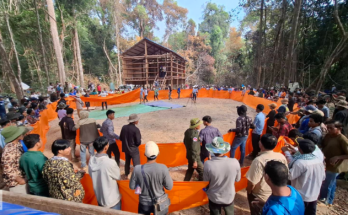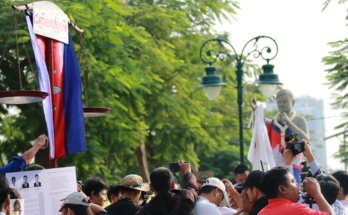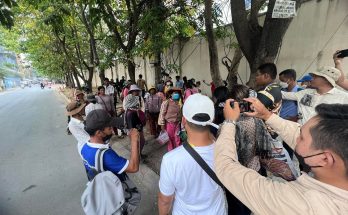November 12, 2015, marked the second anniversary of the death of Mrs Eng Sokhum, a victim of indiscriminate violence and excessive use of force by security forces during an SL garment factory workers’ protest in Phnom Penh’s Stung Meanchey district. It, unfortunately, also marked the passing of two years of denial of justice without appropriate redress for the devastating loss of life for Mrs Eng Sokhum’s family.
Mrs Eng Sokhum was selling rice when security forces fired live ammunition into the crowd of unarmed rioting protesters, who had merely thrown small stones at the violent security forces. She was shot in the chest and died on the way to the hospital; nine other persons suffered serious gunshot wounds.
Despite the existence of smartphone-recorded video footage capturing the disproportionate and unnecessary levels of violence by the security forces, as well as substantive proof that Mr Chuon Sovann, chief of the Phnom Penh Municipal Police, had ordered security forces to use such violence against the unarmed protesters, to this day, neither Mr Chuon Sovann nor any other official or officer have been held accountable, let alone been removed from their post.
The district police were, however, quick in putting out public allegations that the particular bullets causing the death of Mrs Eng Sokhum, were not fired from security forces’ guns.
A spokesperson for the Council of Ministers, Mr Phay Siphan, described Mrs Eng Sokhum as “collateral damage”, as she was at “the wrong place at the wrong time”.
Mr Sar Kheng, Cambodia’s Minister of Interior, even went as far as to praise the “patience” of security forces at the protest and to commend them for their good management of the situation, causing minimal injuries and a low death count.
How about asking: Why are security forces with heavy weaponry still deployed during peaceful protests? Why are security forces not trained in using their firearms in a manner likely to decrease the risk of unnecessary harm? Why has no independent, prompt, thorough and effective investigation been conducted into the security forces’ excessive use of force against unarmed protesters?
No such scrutinising questions were ever addressed by the authorities. This is justice, accountability and the fundamental freedoms in Cambodia for you.
Corruption and impunity have been an infestation in Cambodia for many years, as both feed off each other – most prominently inside law enforcement, governmental structures and the judiciary.
Law enforcement and the judiciary are politically dependent on the RGC, serving as instruments at its disposal in order to push for its political agenda.
Perversely, perpetrators of human rights violations get job promotions and human rights victims are thrown in jail.
Testimony to this reality is the arrest of 39 persons – including monks – subsequent to the violent clashes in Stung Meanchey district; needless to say, none of the persons arrested belonged to the security forces.
This vicious cycle of impunity reigning in Cambodia continues to support the arrest, punishment and sentencing of innocent and unarmed persons exercising their human rights for the crimes committed by those that arbitrarily arrest, punish and sentence victims of human rights violations.
Ny Chakrya is head of the Human Rights and Legal Aid section at ADHOC.
Phnom Penh Post, The second anniversary of a denail of justice, Reader’s letter, 14 November 2015, http://www.phnompenhpost.com/post-weekend/second-anniversary-denial-justice



